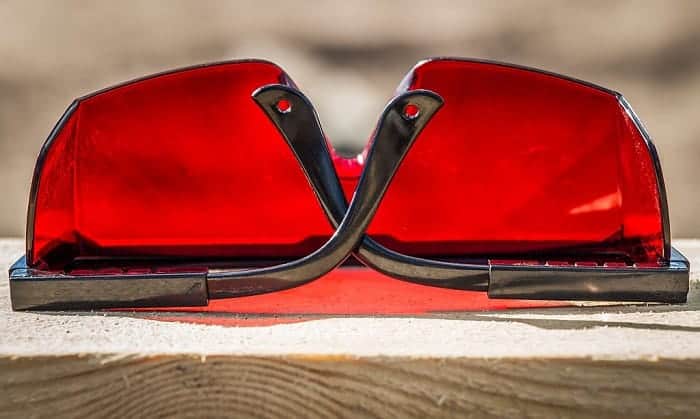Lasers emit health-threatening radiation that causes numerous serious optical injuries and complications when directly exposed to unprotected eyes. It can cause permanent and irreversible corneal and retinal damages which can lead to blindness.
Different industries that use low, mid, and high capacity and density lasers require using laser safety glasses to protect the eyes. However, not everyone knows the basics on how to choose laser safety glasses that will perfectly protect your eyes against hazardous laser wavelength and provide a high VLT percentage and OD range.
Wondering what factors to consider when purchasing one? Read on to find out!
Table of Contents
Five Steps in Choosing the Best Laser Safety Glasses
Step 1: Identify the Optical Density
The Optical Density also referred to as absorbance, is the quantity of light that penetrates the eyes at a particular wavelength, broken down through the lens, and eventually passes through and hits the eye.
It is significant to find out the particular Optical Density range to make sure that it is equipped with the right OD filter to block harmful wavelengths and only allows tolerable and safe amounts of wavelengths. It will also determine whether it matches your industry’s standards to ensure optimum optical protection.
The levels of Optical Density are referred to as ranges and laser glasses with greater OD range obstruct more wavelength light. Meanwhile, safety glasses with lesser OD occludes less wavelength light and provides more optical protection.
In the medical industry, the recommended optical density is 5 and above. You may also opt for higher OD than what’s recommended in the operating manual to provide better eye protection. However, never choose a lower OD than the recommended range as it will be ineffective and loses the point of wearing laser safety glasses.
Information such as the laser safety glass’s performance rating, wavelength, and OD range is indicated in the user manual. Meanwhile, other manufacturers provide a separate warning sign that indicates the wavelength and OD rating information for your convenience.
Step 2: Consider the Visibility Light Transmission (VLT) Needed
Once you’ve successfully determined the wavelength and OD that suits your purpose, the next thing to consider is the Visible Light Transmission of the filter, expressed in percentage, required for you to see clearly through your laser safety glasses.
Visibility light transmission is the quantity of visible light that penetrates through a specific optical lens. It is also described as the eyes’ response to daylight. It is indicated in percentage.
Laser safety glasses with a low VLT percentage have darker lens display and lower visibility and vice versa. Every safety glasses offers a specific VLT level.
Glasses with less than 20% VLT percentage are only beneficial when used in a well-lighted environment. They could pose a potential danger when used in poorly lit areas as you’ll struggle to get a clear view of the surroundings and laser beam.
It’s easy to say to find laser safety glasses with a higher VLT percentage to be able to get higher visibility when looking at a laser beam. However, for certain industries that require exposure to both dimly lighted and well-lighted environments, sticking with a single safety glasses will offer limited visibility.
To make matters worse, glasses with high OD use darker lenses sacrificing optimum visibility in the process so finding a safety glass that offers high OD with a higher VLT level is difficult.
To address this lapse, innovators started producing safety glasses with high OD and high VLT levels giving protection, safety, and visibility that you need for you to deliver your job effectively.
Manufacturers include information regarding OD, VLT, and wavelength in their product specifications to educate the market of the protection that their products offer.
Step 3: Choose the Wavelength
One of the basic steps in choosing the best laser safety glasses is to understand its operational parameter because it will determine the correct wavelength to block and the appropriate wavelength to absorb as well as the Optical Density (OD) that it requires to be able to do so.
Wavelength is used in measuring the distance that lightwaves consume as it travels until it restates its shape again. These wavelengths are measured from peak to peak or apex to apex and are observed through light spectrum or the electromagnetic spectrum wherein it’s displayed from shortest to longest waves.
The light spectrum is measured either in meters or nanometers and is symbolized by the Greek alphabet called lambda or Λ λ.
These waves are invisible to the naked eye that’s why laser safety glasses are important as they block waves that are dangerous for the eyes. Thus, it is imperative to discern the operating wavelength of your safety laser glasses.
Next in line is to identify the Electromagnetic force spectrum. Lasers may have different wavelengths in one spectrum with regions including Ultraviolet that ranges between 100-400 nm, Visible with a range of 440-750 nm, and Infrared or Invisible light with a range of 750-1mm.
It’s also important to understand your laser’s wavelength which is often categorized into:
- Aiming Beam Wavelength – it is categorically classified as “eye-safe”.
- Operating Beam Wavelength – it requires appropriate laser safety glasses to avoid sustaining optical injury
Step 4: Choose the Filter Lenses
The next task on hand is to choose the right filter lenses for you. Typically, there are three types of filter lenses available and each type has a corresponding function.
- Glass Filter
This type of filter lens is the best in terms of absorption level, offers supreme VLT percentage, and offers better protection, especially when using high-powered lasers.
For people working in industries wherein high-density lasers are involved, you barely have any choice left because glass lenses are only the ones suitable for the job. Although it’s more expensive than other filter lenses, it excels in terms of optical visibility and color clarity which makes it worthy of its price.
You may also request custom-tailored laser safety glass with a glass filter wherein the lens is made as per your prescription specifications.
It’s also essential to choose a glass lens that offers protection for wide-ranged applications. This is made possible by combining glass filters to obscure your eyes from direct exposure to laser light while giving you a great OD level.
- Polycarbonate Filters
Polycarbonate lenses are the most popular because they cost less, are lightweight and offer the best impact-resistant feature. Its filter stretches within its 2-3 mm thick lens. It ranks second from the glass lens in terms of wavelength absorption as it’s equipped with a broadband filtering feature and provides higher VLT and OD.
It remains not suitable as protective gear against high power density lasers but performs well in low up to middle range lasers. In purchasing a polycarbonate lens, make sure to check its quality standard whether it fully complies with the ANSI 747 standard.
- Nano Spec Filter Technology
Also known as thin-film coated lenses, the nano spectrum filter technology is a set of reflective coatings which can be incorporated and applied into glasses and polycarbonate lenses for a reinforced protection level and improved range of wavelength absorption.
One of its best features is that it offers the highest VLT level among laser lenses.
Furthermore, it offers the highest OD level, provides premium color balance, and renders superior shield against femtosecond and Pico pulse.
Step 5: Choose the Frame Style
The last step to complete the puzzle on the factors to consider before purchasing a laser safety glass is to choose the most suitable lens. Choosing safety over comfort, especially the type of filter lens you choose or most suitable for your purpose will affect the type of frame style you’ll need which leaves you with fewer options.
- The 10-Frame Fit-over
It is one of the most sought-after frames because it’s economical and typically fits almost all head and face sizes. It’s a bestseller in industries looking to buy laser safety glasses for their workers because it eliminates the need to get individually tailored glasses. It is also commonly used on polycarbonate lenses.
- 35-Frame Spectacle
Ranks second as the most popular type of laser safety glass frame, this type of frame offers a perfect fit over prescription glasses. It also suits people with bigger heads and faces as it is a larger frame compared to its alternatives.
One of the most important perks of a 35-frame spectacle is that it offers wide view vision, provides extra side protection, and is very comfortable to wear. It is also a great option for glass and dielectric coated glasses.
Conclusion
How to choose laser safety glasses that will suit your need, purpose, comfort, and budget can be daunting. But our tips can help you understand the important factors to consider when looking for one.
Beyond anything else, your safety should remain your utmost priority as most optical injuries are irreversible. Comfort is also an important factor because there’s a high tendency of unconsciously removing your safety glasses when it does not fit comfortably on your head and face.

Having worked in the field of personal protective equipment for over two decades, Andrew Carnegie is a specialist in the field.
At EDC, he strives to improve performance efficiency and promote workplace safety for EDC’s readers and customers. He also researches the most up-to-date equipment that has earned relevant accreditation for use in a wide range of industries and specialties.




